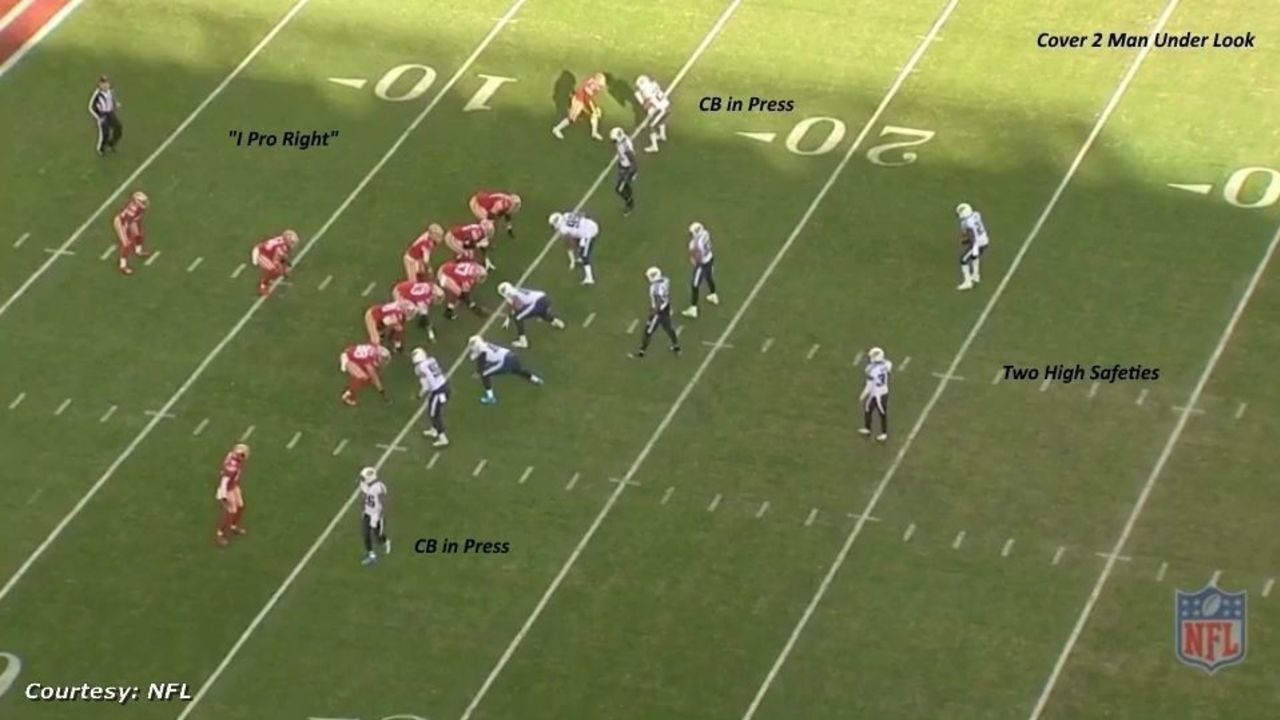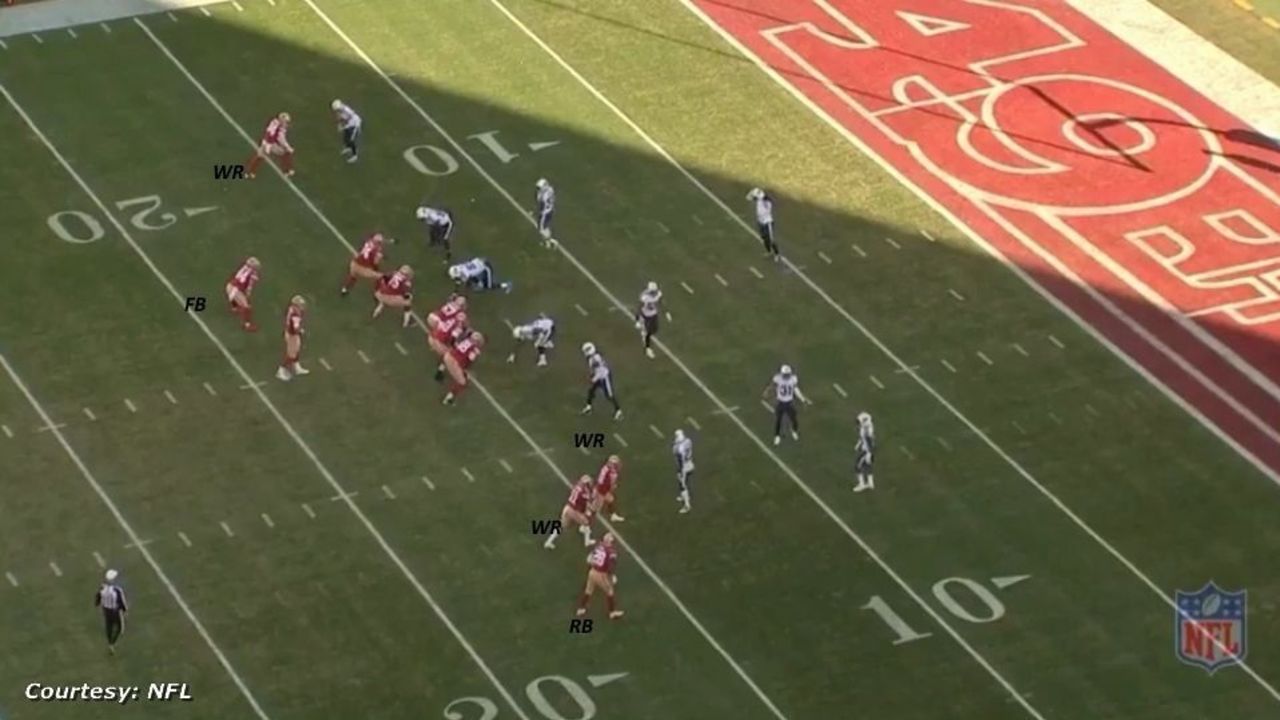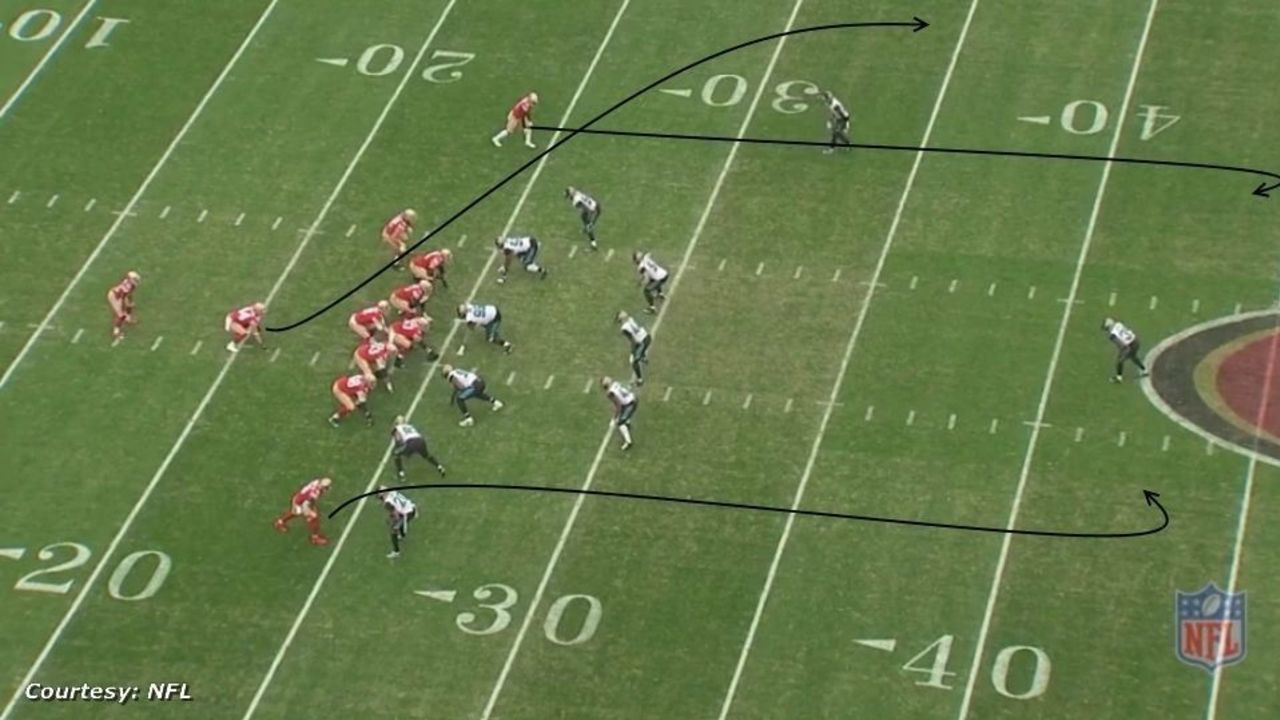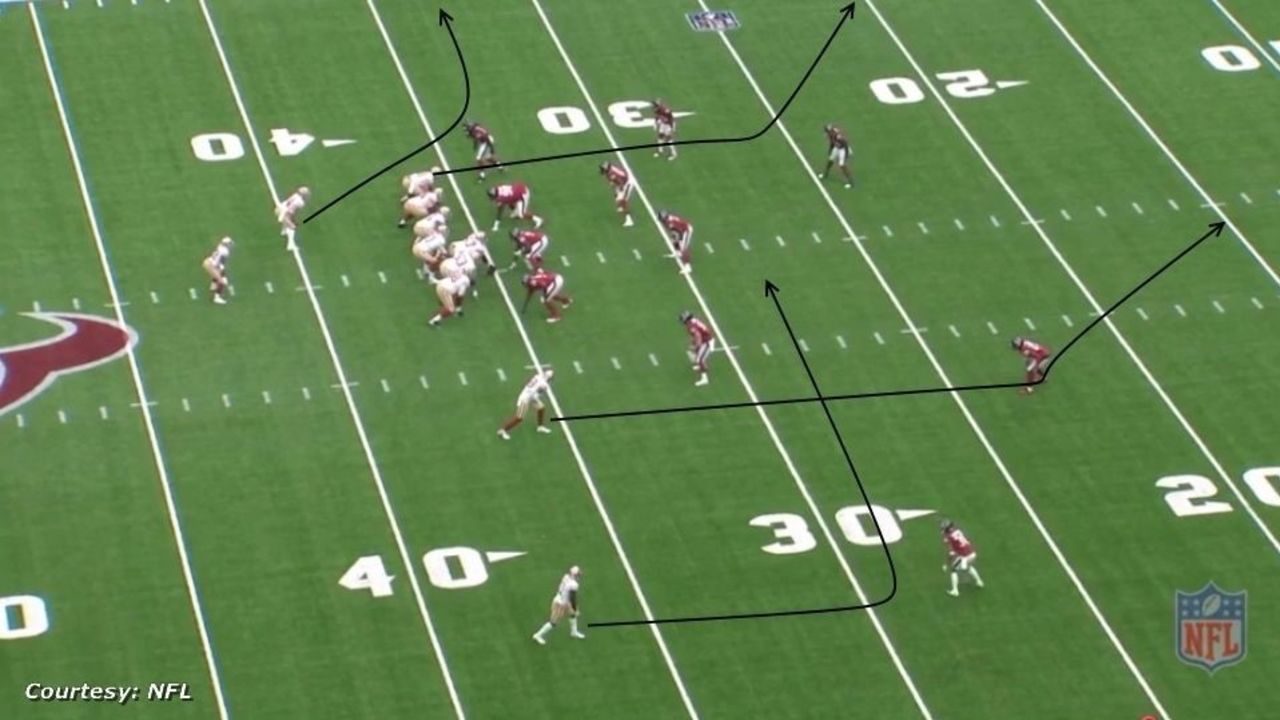How Shanahan's 2-RB scheme elevates Garoppolo, fuels 49ers' passing attack
Jimmy Garoppolo has quickly become one of the NFL's biggest names.
After a stunning midseason trade sent the quarterback from the New England Patriots to the San Francisco 49ers, he energized the football world by leading San Fran to wins in all five games he started. The hype continued this offseason, as Garoppolo's commonly been listed among the top quarterbacks in the NFL, has been the subject of several in-depth profiles, and was even named among the 50 most influential people in sports culture by Bleacher Report.
But while much of the spotlight's been focused on Garoppolo, not enough praise has been directed at 49ers head coach Kyle Shanahan, whose brilliant play designs - his use of two-running back formations, specifically - have made things much easier for his quarterback.
Last season, Shanahan and the 49ers often used a "21" offensive personnel group (two running backs, one tight end, and two wide receivers) that included fullback Kyle Juszczyk and was reminiscent of a time when simply gaining 3 yards on runs - and rarely passing - was an actual offensive philosophy.
But along with running, Shanahan also used this package to design creative concepts in the passing game. The beauty of doing so is that opponents often keep their base defense on the field against the "21," meaning the quarterback has fewer defensive backs to throw against and is facing players who are more suited to stop the run than the pass.
So, let's examine film and pinpoint exactly how Shanahan's used his two-running back scheme to such great effect:
Motion, Movement, and Shifting
Similar to Patriots offensive coordinator Josh McDaniels, Shanahan loves to use movement before the snap, which has a two-fold effect. First, by moving his players around, Shanahan forces the defense to tip its hand. If a defensive back trails a wide receiver in motion, the quarterback gets a clue that he's facing man coverage. If not, that signals a zone. Additionally, by moving around offensive players pre-snap, it's easier to find an exploitable matchup.
Take the below example from Week 15 against the Tennessee Titans, with the 49ers facing a 1st-and-10 on their own 15-yard line. They line up with Juszczyk (No. 44) as the lead in a two-back set that features a tight end and one receiver to the right, an I-formation in the backfield, and a single receiver to the left. Tennessee, seeing this personnel package, keeps its base 3-4 defense on the field (three down linemen, four linebackers, and four defensive backs), and shows a "Cover 2 Man Underneath" scheme with two deep safeties and both cornerbacks in man-coverage alignments.

But then the movement begins. First, the 49ers "trade" the tight end - shifting him from the right side to an identical spot on the left - before receiver Marquise Goodwin (No. 11) motions from the left to the right. In response, the defensive back who was originally across from Goodwin backpedals instead of following him (showing zone coverage), adjusting the look into more of a Cover 3. Meanwhile, Logan Ryan (No. 26) is now across from Goodwin on the right and backs off slightly as the receiver finishes his motion.

What happens next? Goodwin runs a route that breaks in front of Ryan for an easy pitch and catch, and the 49ers have a fresh set of downs:

This is a perfect example of how a well-planned scheme can make things easy for a quarterback. By using "21" personnel, the 49ers get the Titans to keep their base defense on the field. The pre-snap movement gets the defense to alter its coverage while confirming for Garoppolo that he's facing zone coverage. And as soon as Ryan backs off Goodwin to protect the deep outside portion of the field, the receiver has space underneath for an easy gain.
Here's another example of using personnel and motion, again from Week 15 against the Titans. Facing a 3rd-and-6 in the red zone, the 49ers line up using "20" offensive personnel (two running backs, no tight end, and three receivers) against the Titans' 4-2-5 nickel defense. They begin the play with Garoppolo in the shotgun, Juszczyk standing to the left of his quarterback, and running back Carlos Hyde (No. 28) flexed out to the right:

But before the play, Hyde shifts into the backfield, and the Titans' defense again responds - this time showing Garoppolo more of a man-coverage look. They also rotate the free safety down into the box, so the quarterback has a pretty good idea that Tennessee is in a "Zero Blitz" scheme (man coverage in the secondary with everyone else blitzing):

That's exactly what happens. San Francisco has an Air Raid offense staple called a "Mesh Concept," in which two receivers cross underneath. In addition, Juszczyk runs a little wheel route to the left. Because of the traffic created by the mesh underneath, Garoppolo is able to find his fullback open before being hit by a blitzer, and the 49ers move the chains:

Both of these passes are prime examples of a defense getting caught responding to a two-back set that dictates the terms of the play pre-snap.
Play-Action/Run-Pass Option
As you might imagine, play-action is another way Shanahan uses two-back sets in the passing game.
And as mentioned, the "21" personnel package is often used for running plays. NFL teams employed the package on only 7.7 percent of offensive snaps last year, running the football 57 percent of those times (compared to 32 percent when using one running back and three receivers). Meanwhile, the 49ers used the "21" group more than any other team in 2017, and a whopping 42 percent of the time when Garoppolo was under center. That opens up exciting possibilities with play-action fakes in the passing game, as defenders often expect the run when lined up against the two-running back formation.
One such design is the "Yankee Concept," which is a two-receiver, maximum-protection, play-action design that consists of a deep post route and an intermediate crossing route. In Week 14, Garoppolo hit Goodwin for a huge gain on this play against the Houston Texans:

You can see the effect of the play-action fake here by watching the Texans' linebackers. Because of the situation (first down) and the 49ers' "21" personnel, the defense expects a running play. Houston therefore keeps its base 3-4 defense on the field, and both inside linebackers crash downhill in response to the run fake, opening up the throwing lane to Goodwin's crossing route behind them.
Another way Shanahan uses play-action fakes in two-back packages is by designing half-field concepts. These give the quarterback two passing concepts to choose from, one on each side of the field. This could be something as complex as multiple-receiver designs on each side, or something as simple as one receiver to the left and three to the right. The quarterback can make his reads and his ultimate decision on one side of the field or the other, based on the coverage.
Last season, Garoppolo hit on some big plays to his backs and tight ends. Here's one design that incorporates play-action and sets up a half-field read for the quarterback:

On this play, San Fran has "21" offensive personnel in the game. Shanahan sends the two receivers on deep curl routes, but has the fullback, Juszczyk, release along the sideline on a wheel route. After Garoppolo carries out the play-action fake, he has the curl routes and the wheel route to choose from. It works to perfection:

The beauty of this play is that it has an answer whether the defense is playing zone or man coverage. In a zone, the curl routes can break open in front of defenders. In man, as we see here, the play-action fake can delay the linebacker as he attempts to get into coverage, giving the fullback an advantage down the sideline.
Finally, we can incorporate run-pass options (known as RPOs) into this mix. Pairing "21" personnel with an RPO play call is just one more way that Shanahan marries the passing game with two-back personnel groups. Here's an example:

On this play, the 49ers line up with "21" personnel on the field, using an offset I-formation with its strength to the right side. The offense has a running play called to the right, with a potential backside slant on the left.
Tennessee counters with its base 3-4 defense and walks a safety down into the box over the right side of the offense. Seeing the box stacked on the right, Garoppolo chooses the "pass" option and makes the quick decision to throw the backside slant route to the left. While the rest of the offense carries out the running play, including the linemen who run block on the right side, Garoppolo cuts his handoff movement short, spins to the left, and fires to Goodwin.
Half-Field Reads
Finally we can look at some of the aforementioned half-field reads that Shanahan calls when the 49ers are using "21" offensive personnel - this time without play-action fakes. The two different route concepts on each side of the field allow the quarterback to "peek" quickly at one before working the other.
On this play against the Texans, the 49ers run two different concepts to each side of the field. To the left, they run a "Flat-7 Smash," with a corner route being the "7" and the fullback releasing to the flat. On the right side, they run a "Mills" concept - a post route with a crossing route underneath:

The simple design and strong execution leads to a big gain, as San Francisco catches Houston in a blitz and Garoppolo simply flips the ball to Juszczyk in the flat:

The other way the 49ers design these half-field reads using "21" personnel is by sending the backside single receiver on a vertical route for Garoppolo to quickly peek at before working the other side of the field with multiple receivers. This allows the offense to potentially catch the defense in a mismatch or take advantage of a speedy receiver on a vertical route before working to the concept itself.
On this example against the Titans, San Francisco has the single receiver run a comeback route on the left, while running a "spot" concept to the right:

Garrett Celek (No. 88) runs a wheel route from the tight end spot, and is wide open as the other options on his side work underneath. Garoppolo takes a quick look backside at the comeback route before working the right side for a huge gain.
Finally, here's another example of this philosophy - this time against the Jaguars:

The backside receiver runs a "go" route, while the 49ers implement another "Mills" concept with tight end George Kittle (No. 85) running a post route as receiver Louis Murphy (No. 18) runs the crossing route underneath. Garoppolo peeks at the backside vertical route before working to the right, hitting Murphy on the crossing route for a 17-yard gain.
In closing, we can even look at one of the 49ers' biggest offseason moves in the context of Shanahan's affinity for the two-back approach in the passing game.
After running back Jerick McKinnon was signed in free agency, Shanahan said: "A huge bonus on him is when you talk about the pass game. When it comes to separating and beating linebackers and safeties in man-to-man coverage, I definitely think he's an issue for teams. I think this league, when it comes to third downs and things like that, you move the chains based off of matchups, which allows you to get points in the long run."
After signing McKinnon - and based on analyzing the tape - we can surely expect to see plenty more passing from the 49ers out of two-back sets during Garoppolo's first full season under center.
HEADLINES
- Steelers' Watt out for MNF vs. Dolphins after lung surgery
- NFL award rankings: Where does each race stand with 4 weeks to go?
- Week 15 anytime TD bets: Brown highlights 5 value picks
- The Chiefs' dynasty is dead. The Eagles' never even got started
- NFL Week 15 picks: Can Bills prevent Pats from clinching AFC East?